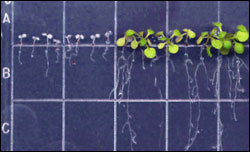Life Sciences and Chemistry
Articles and reports from the Life Sciences and chemistry area deal with applied and basic research into modern biology, chemistry and human medicine.
Valuable information can be found on a range of life sciences fields including bacteriology, biochemistry, bionics, bioinformatics, biophysics, biotechnology, genetics, geobotany, human biology, marine biology, microbiology, molecular biology, cellular biology, zoology, bioinorganic chemistry, microchemistry and environmental chemistry.

Pioneering Study Compares 13 Vertebrate Genomes
Multi-Species Approach Provides Unprecedented Glimpse Into Function and Evolution of the Human Genome
In one of the most novel and extensive comparisons of vertebrate genomic sequences performed to date, a team led by the National Human Genome Research Institute (NHGRI) today reported results that demonstrate how such comparisons can reveal functionally important parts of the human genome beyond the genes themselves.
In a study published in the journal Nature, the researcher

UCLA researcher first to solve structure of membrane transport protein
Led by UCLA physiologist H. Ronald Kaback (Sherman Oaks), an international research team’s 12-year mission to solve the structure of an important protein has paid off. Kaback and his colleagues recently captured the three-dimensional structure of lactose permease (LacY), which moves lactose across the cell membrane of E. coli, a common bacterium.
According to Kaback, LacY is a model for a large family of related transport proteins, many of which are associated with human disease.

Weizmann Institute scienists find that stem cells in the bone marrow become liver cells
They still don’t have a personality, and they’re waiting for the maturity call. Stem cells in our bone marrow usually develop into blood cells, replenishing our blood system. However, in states of emergency, the destiny of some of these stem cells may change: They can become virtually any type of cell – liver cells, muscle cells, nerve cells – responding to the body’s needs.
Prof. Tsvee Lapidot and Dr. Orit Kollet of the Weizmann Institute’s Immunology Department have fo

Key Step for Designer Plants that could clean up Heavy Metals
Researchers at the University of California, San Diego have demonstrated that a chemical that permits plants to detoxify heavy metals can be transported from the roots to stems and leaves, a finding that brings the possibility of using plants to clean up soil contaminated with toxic metals such as lead, arsenic and cadmium one step closer to reality.
A paper detailing the discovery appears this week in an advance online publication of the Proceedings of the National Academy of Science

Targeted DNA vaccine may reverse autoimmune disease
Stanford University Medical Center researchers have developed a way to tailor therapies to combat the specific inappropriate responses of autoimmune diseases in mice. The researchers also have shown that their technique can provide information needed to predict a disease’s progression. Eventually, their work may provide a way to reverse the course of such autoimmune diseases in humans as multiple sclerosis, rheumatoid arthritis and type-1 diabetes by first identifying the immune system culpri

Separating uranium from plutonium
Moscow researchers have made the supercritical carbon dioxide work. Saturated with special reagents, carbon dioxide first extracts uranium from the spent nuclear fuel waste, then extracts plutonium and then flies away into the atmosphere.
As a matter of fact, the spent nuclear fuel consists of multiple elements. First of all, this is uranium that did not burn out and plutonium obtained as a result of nuclear reaction and numerous fission fragments, both radio-active and non-radio-acti